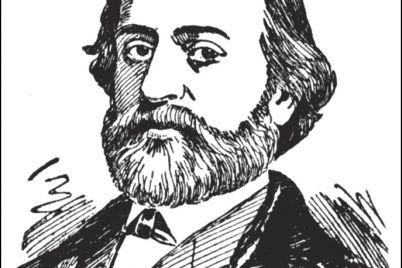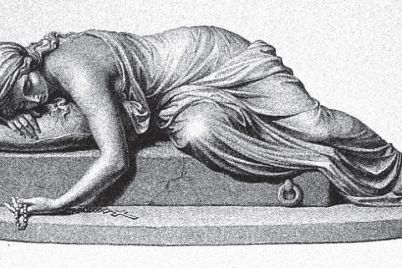The French know a thing or two about swimming. “N’essayez pas de noyer vos chagrins,” says Albert Willemetz, French librettist of the late nineteenth century, “ils savent nager.” “Pour bien nager, un joli caleçon de bain ne vaudra jamais une étendue d’eau,” thinks Léo Campion, French actor (1905-1992). “Si un contemplatif se jette à l’eau, il n’essaiera pas de nager, il essaiera d’abord de comprendre l’eau. Et il se noiera,” this from Henri Michaux, a Belgo-French writer.
And Italians, it seems, know a thing or two about the interpretation of art and its cultural survival in a precarious market. “L’arte sa nuotare” (Art knows how to swim) is a tag seen throughout downtown Florence on street stencils no larger than a loose leaf, created by an artist who goes simply by the name of Blub.
Each of them depicts, in sketch cartoon-style, a great Renaissance masterpiece, with an additional and contemporary ingredient: Dante Alighieri, Federico da Montefeltro’s notorious profile (rendered famous by Piero della Francesca), the Mona Lisa, Sandro Botticelli’s Venus, Leonardo Da Vinci’s portrait and the head and Michelangelo Buonarotti’s David all submersed in water, wearing scuba goggles, enjoying a swim. Their faces have multiplied exponentially over the past year, spreading like wildfire through Florence’s historical core.
The images informing most of these creations are limited to confined spaces – the Louvre, the Galleria dell’Accademia, the Uffizi, online catalogues – and their equally restricted audiences: art history students, art and culture aficionados, travelers trying to make the most of their short trips abroad and, often, the museum-card packages that go with their early hotel bookings.
But as Blub perhaps knows, as funding for humanities programs gets cut systematically across the globe, even during travel, classic art, increasingly overlooked in favour of the much newer “foodie” trend, risks dying in the same places created and maintained to protect, preserve, and praise it. In order to survive, it must swim with the (current) current, out of the small pond behind museum doors and flow into the street. Or at least that’s the message that “Arte sa nuotare” wants to spread.
Florence is not known for its street art. Catching up with a number of more evolved metropolises in recent years, it has begun to boast privately commissioned murals – the one adorning the urban commune “Viale Corsica, 81” is the clearest example – and unofficial embellishments of public property, like the swan-woman spanning the length of the overpass from Viale Redi to the Fortezza da Basso.
Some tag artists have tried to compete with international models: Mr. PacMan (a nod, in name, to Space Invaders) with his larger-than-life spray-paint pencils covering blank spaces increasingly in the Novoli area; Irwin’s rabid dogs along the railroad tracks in a clear tribute to the US’s Sheppard Fairy; The Exit Strategist’s emulation of Banksy, with his sparse sketches and characteristic red balloons. But none of them has yet garnered the exposure or attention – critical or popular – to make of them household names even in their own city.
The only street artist of any renown in Florence is Clet, whose traffic sign creations got him noticed several years ago among young photographers who helped disseminate his work. But Clet is hardly representative of the street art movement or what it represents. Opening a headquarters and mass-production print and replica shop at the crossroads of Florence’s downtown core and the heart of its Oltrarno alternative community – Porta San Niccolò, he has come to define himself as a caterer to consumer culture and not, as all alternative art claims and aims to be, a live option against it. Clet has become trendy without being edgy. His creations no longer speak of public defiance, but of popular taste. More to the point, his work has become synonymous with his name on a path already comfortably paved for him.
By contrast, and despite Blub’s now considerable fame – the cover of a recent issue of Time Magazine features an underwater Pope Francis – “L’arte sa nuotare” remains an anonymous and not-for-profit operation that makes the most of its venue: downtown Florence. It recognizes its city’s cultural heritage and, rather than oppose it with contrasting or competing illustrations of a new-age world or anarchist society, it capitalizes on it to create a rather new beast – an amalgamation of old and new in a place committed to the conservation of this very coexistence.
Before his move to Parliament, as mayor of Florence, Matteo Renzi envisioned and facilitated the refurbishment and reassignment of major historical landmarks whose function had become redundant or unpopular over time – a project current mayor Dario Nardella continues to uphold. Old palaces opened their doors to modern or contemporary art exhibitions: this past summer saw a Jackson Pollock expo hosted at the Palazzo Vecchio.
Restoration efforts cast historical buildings in a contemporary light: Florence’s baptistery and the scaffolding surrounding it was recently covered by a protective plastic case, illustrating in bright colours and in mod style what the final product might look like. Modern dance festivals like “l’Estate al Bargello” were hosted in culturally pregnant places – the Teatro della Pergola and the Limonaia at the Villa Strozzi – while classical music festivals like the annual “Maggio musicale” often included concerts in newer spaces: botanical gardens and university settings.
Since at least 2011, the city has begun to breathe an air of renewal and unconventional reinvention. An air not equally appreciated by all: Renzi’s plans for Florence have come under fire more than once for their perceived desecration of tradition and, on the opposite end of the spectrum, for their failure to look still further ahead at a country no longer defined by its past, but by its present accomplishment.
But “Arte sa nuotare” in some measure demonstrates both the diffusion of Renzi’s vision (within the city, at least) and a concern with the re-popularization of the past – not mutually exclusive programs. Rather than create art for the streets, “Arte sa nuotare” brings extant art to the street and, more importantly, to the people walking it. Ostensibly, and one would hope then, it will eventually bring us all back from the street to the museum, where the reconciliation of past and present can come full circle.
It isn’t so unlike Cosimo I de’ Medici’s program, in the early 1540s, to incur favour with his subjects, as Florence shifted politically from republic to duchy, by recalling in art some of the republic’s great ideals. Then as now, the transition was by no means without contest or hiccup, but then as now, the art made to occupy public spaces proved to be an instrumental tool of popular persuasion.
At times, the most radical thinkers are those who, as Henri Michaux suggests, embrace the wave rather than stand firmly against it. “L’arte sa nuotare” reveals Florence’s first opportunity to assume a place on the international street art stage, in a style befitting of its fundamental nature, and in its own right.
Tania Zampini is an Accenti contributor. She is based in Florence, Italy.



